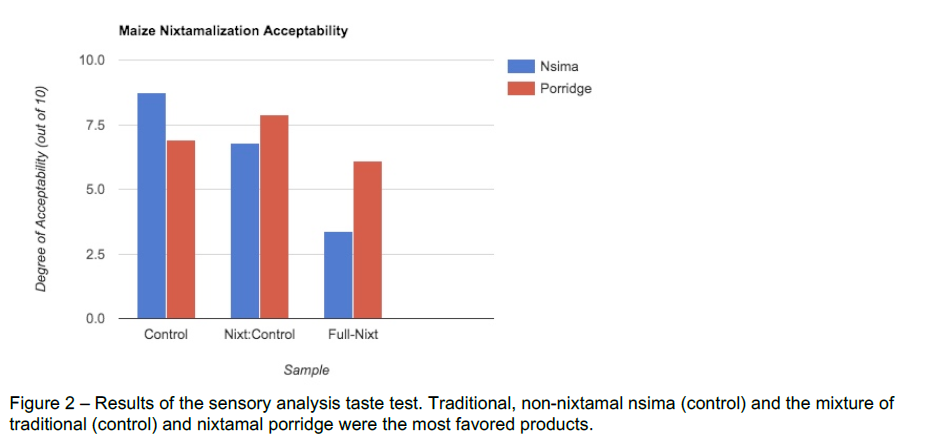Cooper, Annica
Effects of nixtamalization on maize processing in Malawi
Faculty Mentor: Frost Steele; Nutrition, Dietetics, and Food Science
Introduction
Malawi is a small country in southeastern Africa. The main crops that rural Malawians
grow for food are maize, legumes, and dark, leafy greens. Due to this restrictive diet,
many Malawians are at risk for several nutritional deficiencies. In a survey conducted of
Malawian families at the School of Agriculture for Family Independence (SAFI), families
reached an average of only 18.3% of their calcium needs. A calcium deficiency,
especially early in life, can lead to low bone mass and low vitamin D levels, which leads
to rickets or osteomalacia. An ancient Mesoamerican tradition called nixtamalization
turns maize into a great source of calcium. Nixtamalization refers to the soaking of corn
granules in an alkaline solution before processing. This has been seen to increase the
calcium content of the maize upwards of 1760% of the original calcium content under
laboratory conditions1. Nixtamal, or corn processed through nixtamalization, has
become the main calcium source in most Mesoamerican communities that utilize this
process2. In Malawi, the most prevalent alkaline source available would be the through
the collection and boiling of wood ash, of which calcium is a predominant mineral3.
Methodology
To understand the implications of a nixtamal product in Malawi, a sensory analysis was
conducted among local Malawians. Test subjects were recruited from SAFI and from
surrounding areas in Dowa, Malawi. Protocol was accepted by the Institutional Review
Board at Brigham Young University. Two different trials were performed: the first trial
consisted of 15 subjects receiving nsima (solid form) and the second trial had 42
participants with porridge (liquid form). Three samples were provided: product made
from nixtamal flour, traditional flour (control), or a mixture of a 1:1 ratio of nixtamal and
traditional flour. To create nixtamal, the maize was boiled for 60 minutes in ash water
and steeped for 12-14 hours. It was then dried and processed into flour per local
tradition. These flours were tested at Brigham Young University’s Environmental
Analysis Laboratory for mineral content to determine the change in calcium content.
Results
Samples of nixtamal and traditional flour showed a 372% increase in calcium content
among nixtamal flour (Figure 1). The sensory analysis for nsima showed mixed
reactions toward the nixtamal product (Figure 2), with the favorite products being
traditional nsima and the nixtamal/control mixture for the porridge.
Discussion
Participants disliked the taste and texture of the nixtamal nsima primarily because it was
different from the nsima that they were used to eating. However, when the product was
in porridge form, participants from this trial preferred the nixtamal/control mixture to the
control or full nixtamal. The full nixtamal had lower acceptability than the control, but
much higher than the nixtamal nsima product. This shows that Malawians do not
necessarily want to change the product they are familiar with, but are open to
incorporating new food products into their diet. The mixture of nixtamal and traditional
flours offers the incorporation of important vitamins and minerals from both flours.
Conclusion
To provide the best product possible for Malawians, further trials will explore the most
preferred combination of nixtamal and other flours offering added nutritional value into
porridge form. Efforts will also be taken to educate Malawians on the nixtamalization
process and to determine acceptability among children, an important demographic that
is susceptible to nutritional deficiencies.
Sources
1. Bressani, R., Turcios, J. C., Colmenares de Ruiz, A.S. (2004). Effect of processing conditions on phytic acid,
calcium, iron, and zinc contents of lime-cooked maize Journal of Agriculture and Food Chemistry, 52, 1157-1162.
2. Rojas-Molina, I., Gutiérrez, E., Rojas, A., Cortés-Álvarez, M., Campos-Solís, L., Hernández-Urbiola,
M., Rodríguez-García, ,M.E. (2009). Effect of temperature and steeping time on calcium and phosphorus content in
nixtamalized corn flours obtained by traditional nixtamalization process. Cereal Chemistry, 86(5), 516-521.
3. Etitgni, L., Campbell, A. G. (1991). Physical and chemical properties of wood ash. Bioresource Technology, 37,
173-178.


